
The Act of Parliament permitting the incorporation of the Peak Forest Canal Company and authorised construction of the canal was Act 34 George III cap 26, which received the Royal Assent on the 28 Mar 1794 and became effective on the 20 May 1794.
An Act for making and maintaining a Navigable Canal from and out of the Canal Navigation from Manchester to or near Ashton-under-Lyne and Oldham, in the County Palatine of Lancaster, at the intended Aqueduct Bridge in Dukinfield, in the County of Chester, to or near to Chapel Milton, in the County of Derby; and a Communication by Railways or Stone Roads from thence to Load's Knowl, within Peak Forest, in the said County of Derby; and a Branch from and out of the said intended Canal to Whaley Bridge, in the said County of Chester.
Later, the Peak Forest Canal Company obtained another two Acts of Parliament to empower it to complete the construction of the canal.
Act 40 George III cap 38, Royal Assent 30 May 1800
An Act for altering and amending an Act, passed in the Thirty-fourth Year of the Reign of His present Majesty,
for making and maintaining the Peak Forest Canal; and for granting to the Company of Proprietors of the said Canal further and other Powers.
Act 45 George III cap 12, Royal Assent 18 Mar 1805
An Act for enabling the Company of Proprietors of the Peak Forest Canal more effectually to provide for the Discharge of their Debts,
and to complete the said Canal, and the Cut, Railways, or Stone Roads and other Works thereof.
The line of this narrow canal was to be from the southern end of the Tame Aqueduct in Dukinfield, Cheshire, where it was to connect with the Ashton Canal, passing through Newton, Hyde, Woodley, Bredbury, Romiley, Marple, Strines, Disley, Newtown (New Mills), Furness Vale and Bugsworth and from there to its projected terminus at Chapel Milton. From Chapel Milton, a Railway or Stone Road was to be built to Load's Knowl (near Dove Holes). A short branch canal to Whaley Bridge was also to be cut. The Act for the Peak Forest Canal became effective on the 20 May 1794 and Thomas Brown, the Resident Engineer, cut the first clod.
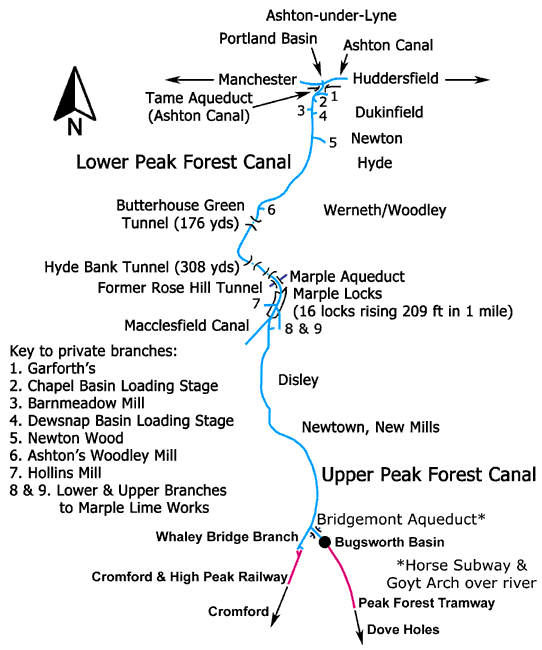
The Deposited Plan of the proposed canal (initially known as the intended Derbyshire Canal), was drawn up by Thomas Brown and this plan and the estimates were deposited with the Clerk of the Peace for Derbyshire in 1793. This was done on behalf of the Peak Forest Canal Company by their Law Clerks, Worthingtons of Altrincham. The plan envisaged two flights of locks, one at Marple and the other at Whitehough beyond Bugsworth. There were to be three canal tunnels, these being at Butterhouse Green, Hyde Bank and Rose Hill, and a tramway tunnel at Stodhart.
As built, the Peak Forest Canal lay entirely in the County Palatine of Chester with the exception of a short section on the approach to Bugsworth, which was in Derbyshire. In the event, the canal was terminated at Bugsworth in order to avoid construction of Whitehough Locks and preclude the problem of an inadequate water supply for the summit pound and terminal basin at Chapel Milton. This would have required the construction of a special reservoir at Wash, which may not have been sufficient to guarantee and adequate supply of water. An additional, and less appreciated, reason for this change to the design was the discovery of an outcrop of gritstone just beyond Bugsworth, where the company subsequently opened the successful Crist Quarry and the later Barren Clough Quarry.
The company reached their decision to modify the design on the 8 Jul 1795 and this was done on the advice of Benjamin Outram and Thomas Brown, their consulting and resident engineers respectively. The Committee of the Peak Forest Canal Company expressed the opinion that it was in the interests of the company to:
make the canal as far towards Chapel Milton as possible.
The effect of this was that the Peak Forest Canal terminated at Bugsworth rather than at the projected terminus at Chapel Milton, which was two miles away, hence the Peak Forest Tramway was built two miles longer. The canal was the a little over 14½-miles long and the tramway was about six-miles long.
In Oct 1795, the Committee asked Outram to stake out the line of Marple Locks but the company was becoming overwhelmed with financial problems, as a result of which their construction was delayed.
The Upper Peak Forest Canal and Peak Forest Tramway opened for trade on the Wednesday, 31 Aug 1796. The Lower Peak Forest Canal, between Dukinfield and Marple Aqueduct, was open in 1798 and Marple Aqueduct opened on the 1 May 1800. Meanwhile, the need for locks at Marple was overcome by the construction of the temporary Marple Tramway that was in use between 1798 and 1807. The top four locks at Marple (locks 13, 14, 15 and 16) were opened on the 13 Oct 1804 but it was not until Nov 1805 that the remaining 12 locks were opened. Thus, it was not until Nov 1805 that the Peak Forest Canal was fully open throughout its entire length. As a consequence, Marple Locks and Tramway were operated in tandem for two years.
Structure of the Company of Proprietors of the Peak Forest Canal
1794-1846
General Assembly of the Company of Proprietors of the Peak Forest Canal
General Committee
Committee
Sub-Committee & Special Sub-Committees
Law Clerks (Solicitors)
Principal Agent
Treasurers (Bankers)
Bookkeepers
Surveyer & Resident Engineer
Wharfingers
Lockkeepers
Lengthmen
Other Employees
Opening of the Peak Forest Tramway
Peak Forest Canal Water Supply
The Peak Forest Canal receives its water supply by gravity feed from three sources:
Combs Reservoir (capacity 339 million gallons)
Toddbrook Reservoir (capacity 296 million gallons)
The Black Brook
Water from the two reservoirs enters the canal at the terminus of the Whaley Bridge Branch and water from the Black Brook enters the canal at the head of the Middle Basin Arm at Bugsworth Canal Basin. The Black Brook can supply up to 925,000 gallons/day.
| 28 Mar 1794 | Act 34 George III cap 26 received the Royal Assent. This Act incorporated the Company of Proprietors of the Peak Forest Canal and authorized construction of the canal. |
| 20 May 1794 | The Act became effective for cutting and building the canal. |
| 31 Aug 1796 | The Upper Peak Forest anf Peak Forest Tramway opened for Trade. This enabled Samuel Oldknow's Marple Lime Works to become operational. |
| May 1798 | Marple Tramway opened to bypass the unfinished Marple Locks. |
| 1 May 1800 | Marple Aqueduct was filled with water from the previously completed Lower Peak Forest Canal. |
| 30 May 1800 | Act 40 George III cap 38 received the Royal Assent. This Act empowered the comany to complete construction of the canal. |
| 13 Oct 1804 | Locks 13 to 16 at Marple were opened. This improved the efficiency of Maple Lime Works. |
| 18 Mar 1805 | Act 45 George III cap 12 recieved the Royal Assent. This Act empowered the comany to complete construction of the canal. |
| 5 Nov 1805 | James Meadows Sr (the Ashton Canal Co's Pricipal Agent) was appointed as the Joint Principal Agent of both canal companies. Following the death of his father in 1831, James Meadows Jr, was appointed as the Joint Principal Agent of both canal companies. An Agent is legally empowered to act on behalf of a company. |
| 12 Nov 1805 | Marple Locks were opened throughout. |
| Feb 1807 | Marple Tramway closed. |
| 6 Jul 1831 | The Cromford and High Peak Railway opened throughout and this linked the Cromford Canal at High Peak Wharf to the Peak Forest Canal at Marple. |
| 9 Nov 1831 | The Macclesfield Canal opened throughout and this linked the Peak Forest Canal at Marple with the Trent and Mersey Canal at Hall Green, near Kidsgrove. |
| 5 May 1837 | The Sheffield, Ashton-under-Lyne and Manchester Railway Company was incorporated and their railway line opened on the 17 Nov 1841. |
| 1 Jan 1846 | James Meadows Jr, the Joint Principal Agent of the Ashton and Peak Forest Canal Companies, was appointed the Clerk of the Sheffield, Ashton-under-Lyne and Manchester Railway Company. |
| 25 Mar 1846 | The Peak Forest Canal Company was leased to the Sheffield, Ashton-under-Lyne and Manchester Railway Company. This company was a forerunner of the Manchester, Sheffield and Lincolnshire Railway Company. This acquisition was made by means of what is known as a perpetual lease, the annual consideration being £9,324 18s 0d. Hence, the Peak Forest Canal Company was an independent company for 51 years 11 months and 27 days, from the 28 Mar 1794 until the 25 Mar 1846. |
| 27 Jul 1846 | The Manchester, Sheffield and Lincolnshire Railway Company was incorporated. |
| 1 Jan 1847 | The Sheffield, Ashton-under-Lyne and Manchester Railway Company; the Sheffield and Lincolnshire Junction Railway Company; the Great Grimsby and Sheffield Junction Railway Company and the Grimsby Dock Company all amalgamated to form the Manchester, Sheffield and Lincolnshire Railway Company. As a consequence of this amalgamation, the Ashton, Peak Forest and Macclesfield Canals became collectively known as the Western Canal. |
| 2 Aug 1863 | Ownership of the Peak Forest Canal Company passed to the Manchester, Sheffield and Lincolnshire Railway Company. |
| 2 Aug 1883 | The Peak Forest Canal Company was dissolved and the canal and tramway were vested in the Manchester, Sheffield and Lincolnshire Railway Company. An Act obtained by the railway company annulled the perpetual lease and this enabled the Peak Forest Canal Company to be dissolved. Between 1846 and 1883 the only functions of the original Peak Forest Canal Company were to distribute any dividends payable to its shareholders and to pay interest on any outstanding loans entered into prior to 1846. |
| 1 Aug 1897 | The Manchester, Sheffield and Lincolnshire Railway Company changed its name to the Great Central Railway Company. This change of name was prompted as a result of the company now having a rail connection to London. |
| Great War 1914-18 |
Rail companies came under government control and this control also extended to canals owned by railway companies. |
| 12 Dec 1922 | The Amalgamation Tribunal, formed as a result of the Railways Act of 1921, ratified the North Eastern, Eastern and East Scottish railway scheme whereby the Great Central Railway Company was to cease to exist at the end of 1922 to become an integral part of the London and North Eastern Railway Company. |
| 1 Jan 1923 | The London and North Eastern Railway Company owned the Western Canal, which included the Peak Forest Canal. |
| 31 Jul 1925 | The London and North Eastern Railway Company Act, 15 & 16 George V cap 52, was passed and a clause in this Act permitted the legal abandonment of the Peak Forest Tramway. |
| 6 Aug 1947 | A Transport Act was passed as a consequence of which the British Transport Commission (BTC) was established and they, in turn, established their Inland Waterways Division. |
| 1 Jan 1948 | The London and North Eastern Railway Company was nationalised, along with the other three railway companies, under the terms of the 1947 Transport Act. Consequently, the Peak Forest Canal, as well as many other canal undertakings passed under the control of the Inland Waterways Division of the BTC. Subsequently, the Inland Waterway Division adopted the name, British Waterways Board (BWB). |
| 25 Oct 1968 | Another Transport Act became effective and this Act conferred a Charter on the British Waterways Board that provided it with a description, a constitution and a grant of rights and also laid down it powers and duties. Later, the name was changed to British Waterways (BW). Under the terms of this Act, the Peak Forest Canal from the top of Marple Locks to Whaley Bridge Juntion and the Whaley Bridge Branch became Cruising Waterways. The Lower Peak Forest Canal, Marple Locks and the main line of the canal between Whaley Bridge Junction and Bugsworth Canal Basin became Remainder Waterways. The Ashton Canal was also designated as a Remainder Waterway. It was only necessary for British Waterways Board to deal with them '···· in the most economical manner possible ····.' Consequently they became derelict and unnavigable. |
| 13 May 1974 | The Lower Peak Forest Canal and Marple Locks, as well as the Ashton Canal, were officially re-opened after becoming derelict in the 1960s. |
| 20 Dec 1977 | Bugsworth Canal Basin at the terminus of the Peak Forest Canal becomes a Scheduled Ancient Monument. English Heritage List Entry Number: 1021384, Legacy System No. 35608, Derbyshire County Number: 242. |
| Easter 2005 | Bugsworth Canal Basin was officially re-opened after lying derelict since the 1920s. |
| May 2011 | Eight transition trustees were appointed to oversee the establishment of the Canal & River Trust that will take responsibility for the care of the historic waterways of England and Wales cared for by British Waterways. |
| 11 Oct 2011 | The Canal & River Trust was incorporated as a charitable company. |
| 2 Jul 2012 | The Canal & River Trust formally took over the work of British Waterways. |
| 12 Jul 2012 | The Canal & River Trust was publicly launched. |
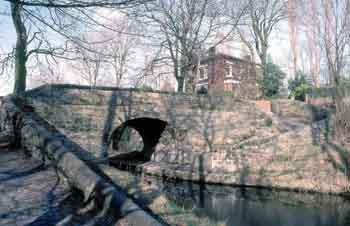
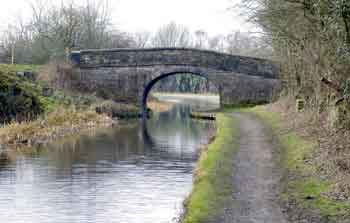
Captain Clarke's Bridge on the Lower Peak Forest Canal, 1980s.
Burgess' Bridge on the Lower Peak Forest Canal, Feb 2006.
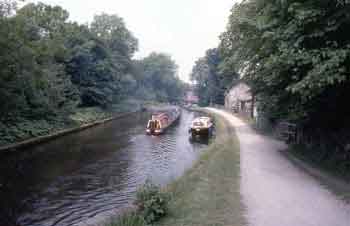
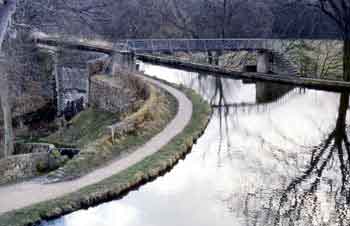
Lock 1 of Marple Locks, Jun 1974.
Whaley Bridge Junction, 1980s.
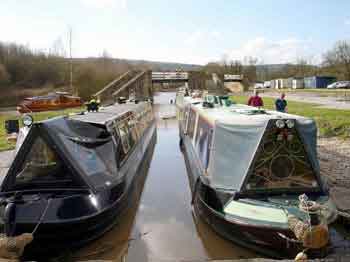
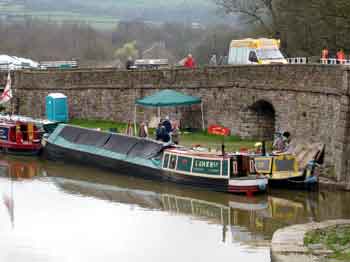
The Lower Basin Arm at Bugsworth Canal Basin, Mar 2005.
The Middle Basin at Bugsworth Canal Basin with Joel and Maria working-boats, Mar 2005.